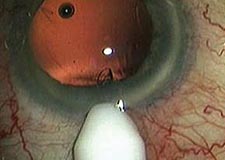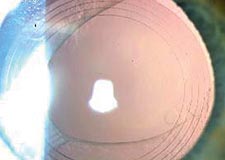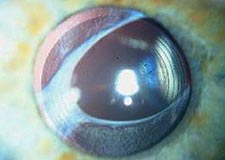ThinOptX rollable acrylic IOL yields good outcomes at 1 year
Surgeon says lens continues the progression toward smaller incision sizes.
SAN FRANCISCO — The ThinOptX lens is demonstrating good visual acuity results and predictability, stability and safety at 1 year, according to a report here.
Dimitrii Dementiev, MD, speaking at the American Society of Cataract and Refractive Surgery 2003 Symposium, described his experience with the lens. Dr. Dementiev and colleagues at his centers in Moscow and Milan have implanted 57 lenses in uncomplicated cataract procedures that now have 1-year follow-up. The patients had an average age of 80 years and a preop best corrected visual acuity of less than 20/60.
“In the fellow eye, an Alcon AcrySof lens was implanted,” he said. “All phacoemulsification was performed under topical anesthesia using either the Alcon Legacy or the Optikon Micro Tip.”
The ThinOptX lens is a plate-haptic IOL of an acrylic material.
It has a one-piece design, 6-mm optic with three or four different optic zones, depending on the power of the lens.
For implantations, the physicians at first rolled the IOL between two fingers, and then they developed a series of injectors.
Establish predictability
The purpose of the study was to evaluate the safety of the ThinOptX lens, to see how well it worked with small-incision phaco and to compare it to the AcrySof lens, Dr. Dementiev said.
“We wanted to know the predictability and stability of refraction and to see if the implant would remain in a stable position. Quality of vision was another target,” he said.
The surgeons also wanted to find or make the right instruments to ease the surgery. The lens was at first rolled to a standard implant size of 1.45 mm.
“But the first injector we used was not so good, as it was not easy to remove the forceps from the cartridge after the implant was rolled, and the implant was scrunching inside the cartridge during the insertion,” Dr. Dementiev said. He described the lens as being very thin and elastic when it is wet.
In a second injector design, the implant was put on a plate and inserted into the injector, like a cigarette roller, Dr. Dementiev said.
“It was injected out in the standard tube size, 1.4 mm, and inserted in the eye,” he said. “This injector was better, but the implanter was shooting pretty strong, which was not good because that can damage the rhexis. It was also very expensive.”
They finally designed a disposable roller, allowing the lens to be rolled before making the phaco procedure.
“The implant can be rolled, put in this kind of puzzle, and then with the hands, just squeezed and the implant is rolled inside,” he explained. “You can keep it (rolled) in the original bottle of the implant for 10 minutes while you are making your phaco.” After the procedure is finished, the implant can be taken out of the bottle and inserted using forceps, no injector needed.
|
| 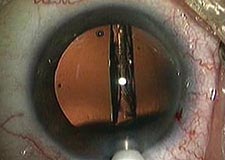 |
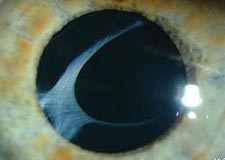 | 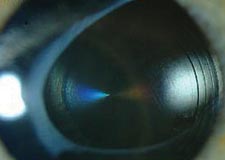 |
|
| |
Results
Following implantation of the ThinOptX lens, all patients had visual acuity of 20/30 or better at 24 hours after surgery. No patients complained of glare or ocular halos, he said.
“Predictability was pretty good, as we have only one case with a postop refraction of –2 D. This patient had a small capsulorrhexis, and the implant floated up toward the anterior capsule and did not sit in the right position,” Dr. Dementiev said. “I performed Nd:YAG laser a couple of days later and the implant went back into position and the refraction came back to 0.5 D.”
Dr. Dementiev said the use of an ultra-small incision with the ThinOptX makes surgery less traumatic, with quick visual rehabilitation and little chance of induced astigmatism.
“In this study, 57 patients with ThinOptX in one eye and AcrySof in fellow eye for comparison had no glare and no halos,” he said. “However, the patients also had no preference for one eye over the other eye.” He added that the lens had good predictability of refractive effect and the refraction was stable at 1 year.
“Surgical technique continues to be improved with injectors and rollers,” Dr. Dementiev said. “As technology progresses, incisions will become even smaller, and I believe that with new developments with phaco machines, incisions of 1 mm or 1.5 mm will be common in the near future.”
For Your Information:
- Dimitrii Dementiev, MD, is in practice at San Babila Day Hospital, Via Stoppani 36 Milan, 20123, Italy; (39) 20293581301; fax: (39) 022046943; e-mail: d3@iol.it. Dr. Dementiev has a financial interest in ThinOptX.
- ThinOptX can be reached at PO Box 784, Abingdon, VA 24212; (276) 623-2258; fax: (276) 623-5661; e-mail: ThinOptX@naxs.net; Web site: www.thinoptx.com.

